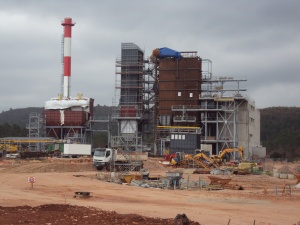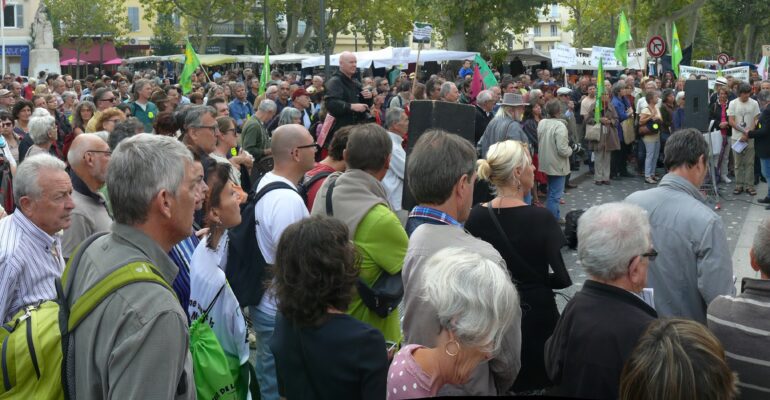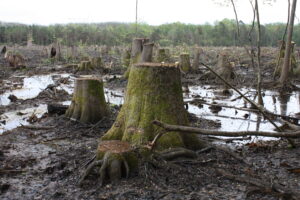Gardanne, France – How biomass burning wrecks Europe’s forests
By guest author Fred Pearce, author and journalist – article from Fern’s report ‘Up in Flames’
Gardanne, near Marseilles in southern France, is a small town with a large power station. The Centrale Thermique de Provence has the tallest chimney in France. At 300 metres high, it is only just shorter than the Eiffel Tower and dominates the town. From early 2016, the former coal-burning station will start burning wood chips.
E.ON, the German utility that owns the plant, claims the conversion will bring clean power to almost half a million households and reduce CO₂ emissions by 600,000 tonnes a year, while ensuring the survival of the plant and its jobs for another 20 years. The plant would otherwise have had to close to meet EU air-quality regulations. The Sarkozy administration, which gave the plan its approval back in 2011, hoped to bolster the economy of a region suffering from the loss of one of France’s last deep coal mines.
But there is a problem for E.ON: where will it get the wood?
The original plan was to source all the 850,000 tonnes of biomass needed annually from within 400 kilometres of the plant, at least from 2025, with some imports till then. Environmentalists and forest communities are up in arms. “Our rural, mountainous and forested region is being prioritized for supplying the timber,” says Nicholas Bell of SOS Forêt du Sud. With 80 per cent of the biomass expected to come from trees cut for the purpose, he forecasts “carnage in the Cevennes”, the much-loved and biodiverse forested mountains nearest to the plant, with its famous sweet chestnuts especially at risk.
The government has agreed that French electricity consumers should subsidise the biomass plant to the tune of 70 million euros for each of the next 20 years – a total of 1.4 billion euros. This subsidy comes from a levy on electricity bills intended to underwrite supplies to remote rural areas as well as to support renewables. Till now, the only biomass projects funded by the levy have been small community schemes. Gardanne is by far the biggest project under the scheme. The deal threatens to set a precedent for a string of similar mega-projects that could threaten France’s forests, and those of neighbouring European countries.
 Inova biomass plant in Brignoles, France (c) Collectif SOS Forêt du Sud
Inova biomass plant in Brignoles, France (c) Collectif SOS Forêt du Sud
There is support for the Gardanne scheme among the region’s political elite, including Gardanne’s communist mayor and the locally powerful CGT trades union. But there is widespread grassroots opposition among villagers in the areas likely to see logging to feed the plant. Local mayors in the Cevennes were not consulted. In late 2014, many of them supported a petition asking Ségolène Royal, the minister for ecology, sustainable development and energy in the current Hollande administration, to halt the project. Through the summer of 2015, local protests grew.
Jean-Louis Joseph, mayor of La Bastidonne and president of the Luberon regional park, said: “This project will turn our local wood sector upside down. We’re not against bioenergy: in Luberon, we have 55 public bioenergy boilers, what we’re worried about is the sheer size of this project. This power station seems to pose an enormous risk to our forests, for our biodiversity. I think we’ll lose more jobs than we’ll gain”.
“There is a timber war going on in our region, with too many competing demands for its timber”, says Bell. Smaller biomass plants in nearby Pierrelatte and Brignoles already burn wood from its forests. And a big paper mill, at nearby Tarascon, consumes more than a million cubic metres of timber a year. Leaders of the paper industry have called for restrictions on biomass burning to protect their wood supplies.
The Gardanne scheme is turning into a political millstone for the government, which is stuck with a 20-year contract signed by its predecessor that would trigger hefty compensation claims if it were abandoned. Faced with growing dissent, ministers have pushed E.On to source three-quarters of the plant’s biomass from abroad initially, but with the imports declining to zero within ten years. It remains unclear where these imported wood chips will come from. But the Baltic states, Romania and Ukraine have all been proposed.
So any benefit for the Cevennes from such change of tack could be bad news elsewhere in Europe or even beyond…
Photo credit: Demonstration in Gardanne, southern France (c) Collectif SOS Forêt du Sud
Note: The views and opinions expressed in this guest blog post are those of the author and are not necessarily supported by BirdLife Europe/EEB/T&E.





